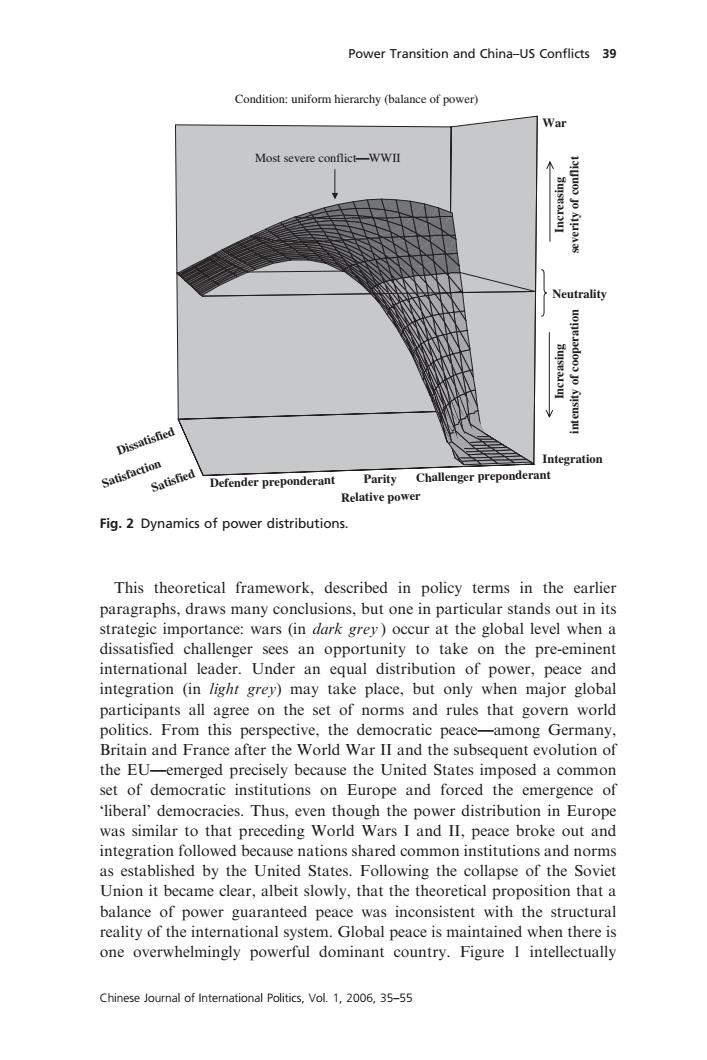正在加载图片...

Power Transition and China-US Conflicts 39 Condition:uniform hierarchy (balance of power) War Most severe conflict-WWII 个 Neutrality Dissatisfied Integration Satisfaction Satisfied Defender preponderant Parity Challenger preponderant Relative power Fig.2 Dynamics of power distributions. This theoretical framework,described in policy terms in the earlier paragraphs,draws many conclusions,but one in particular stands out in its strategic importance:wars (in dark grey)occur at the global level when a dissatisfied challenger sees an opportunity to take on the pre-eminent international leader.Under an equal distribution of power,peace and integration (in light grey)may take place,but only when major global participants all agree on the set of norms and rules that govern world politics.From this perspective,the democratic peace-among Germany, Britain and France after the World War II and the subsequent evolution of the EU-emerged precisely because the United States imposed a common set of democratic institutions on Europe and forced the emergence of "liberal'democracies.Thus,even though the power distribution in Europe was similar to that preceding World Wars I and II,peace broke out and integration followed because nations shared common institutions and norms as established by the United States.Following the collapse of the Soviet Union it became clear,albeit slowly,that the theoretical proposition that a balance of power guaranteed peace was inconsistent with the structural reality of the international system.Global peace is maintained when there is one overwhelmingly powerful dominant country.Figure I intellectually Chinese Journal of International Politics,Vol.1,2006,35-55This theoretical framework, described in policy terms in the earlier paragraphs, draws many conclusions, but one in particular stands out in its strategic importance: wars (in dark grey ) occur at the global level when a dissatisfied challenger sees an opportunity to take on the pre-eminent international leader. Under an equal distribution of power, peace and integration (in light grey) may take place, but only when major global participants all agree on the set of norms and rules that govern world politics. From this perspective, the democratic peace—among Germany, Britain and France after the World War II and the subsequent evolution of the EU—emerged precisely because the United States imposed a common set of democratic institutions on Europe and forced the emergence of ‘liberal’ democracies. Thus, even though the power distribution in Europe was similar to that preceding World Wars I and II, peace broke out and integration followed because nations shared common institutions and norms as established by the United States. Following the collapse of the Soviet Union it became clear, albeit slowly, that the theoretical proposition that a balance of power guaranteed peace was inconsistent with the structural reality of the international system. Global peace is maintained when there is one overwhelmingly powerful dominant country. Figure 1 intellectually Relative power Defender preponderant Parity Challenger preponderant Satisfaction Dissatisfied Satisfied Condition: uniform hierarchy (balance of power) Neutrality War Integration Increasing severity of conflict Increasing intensity of cooperation Most severe conflictWWII Fig. 2 Dynamics of power distributions. Power Transition and China–US Conflicts 39 Chinese Journal of International Politics, Vol. 1, 2006, 35–55